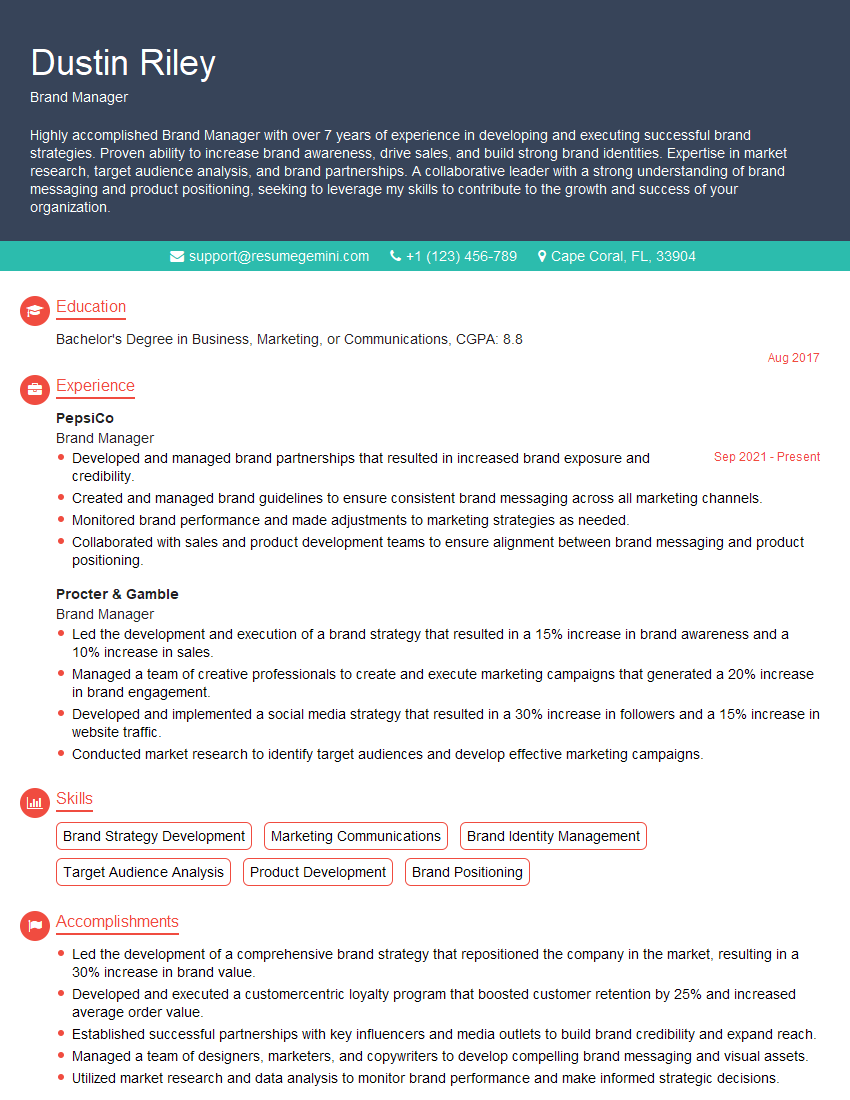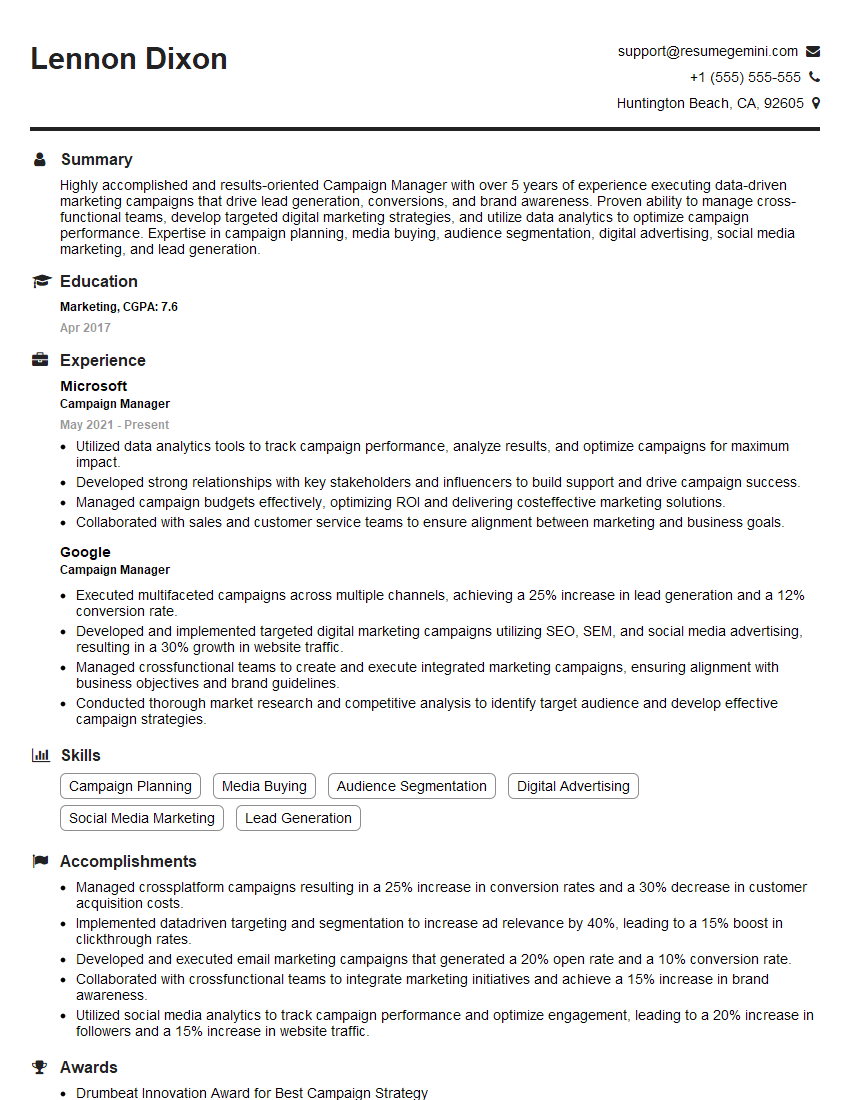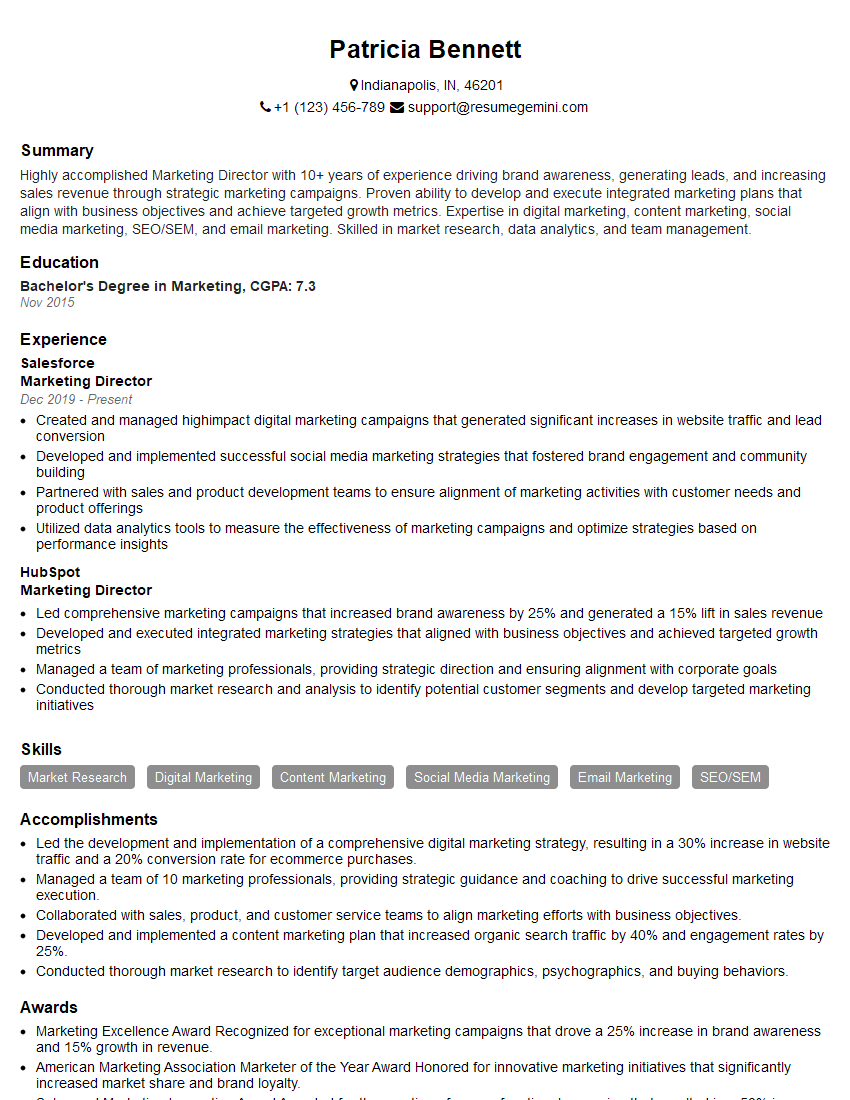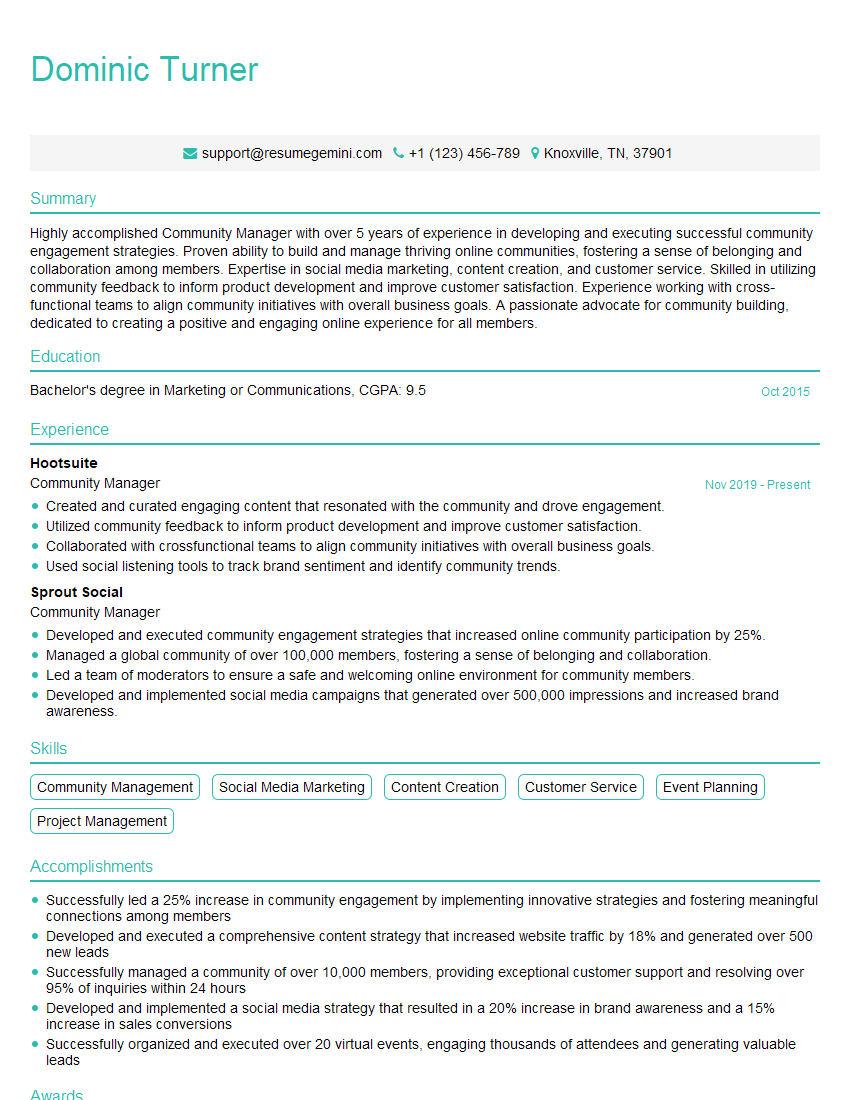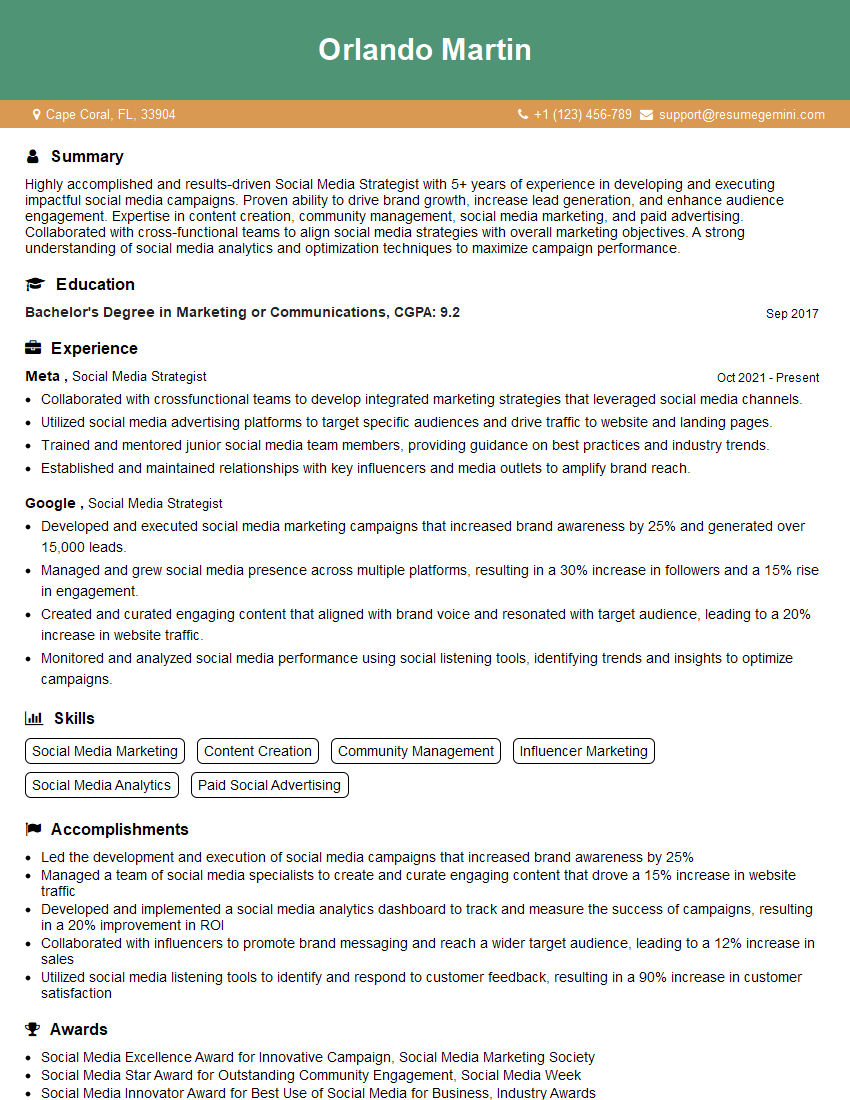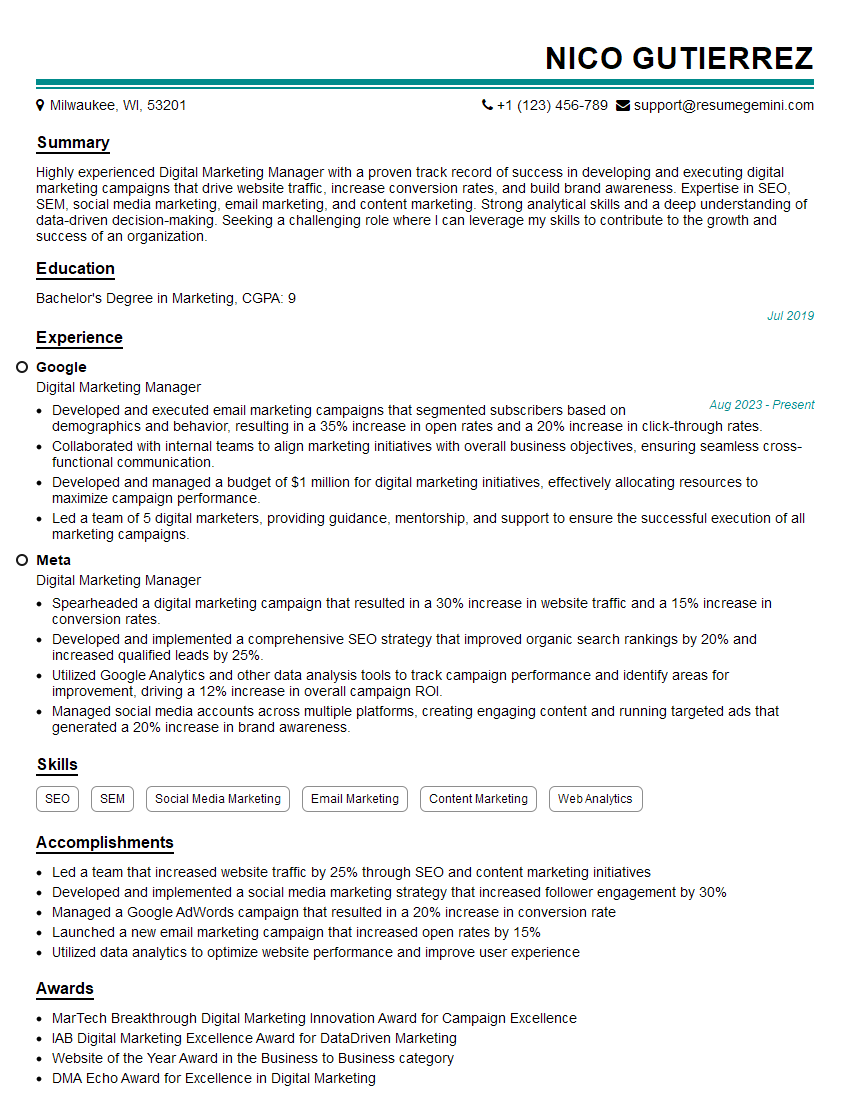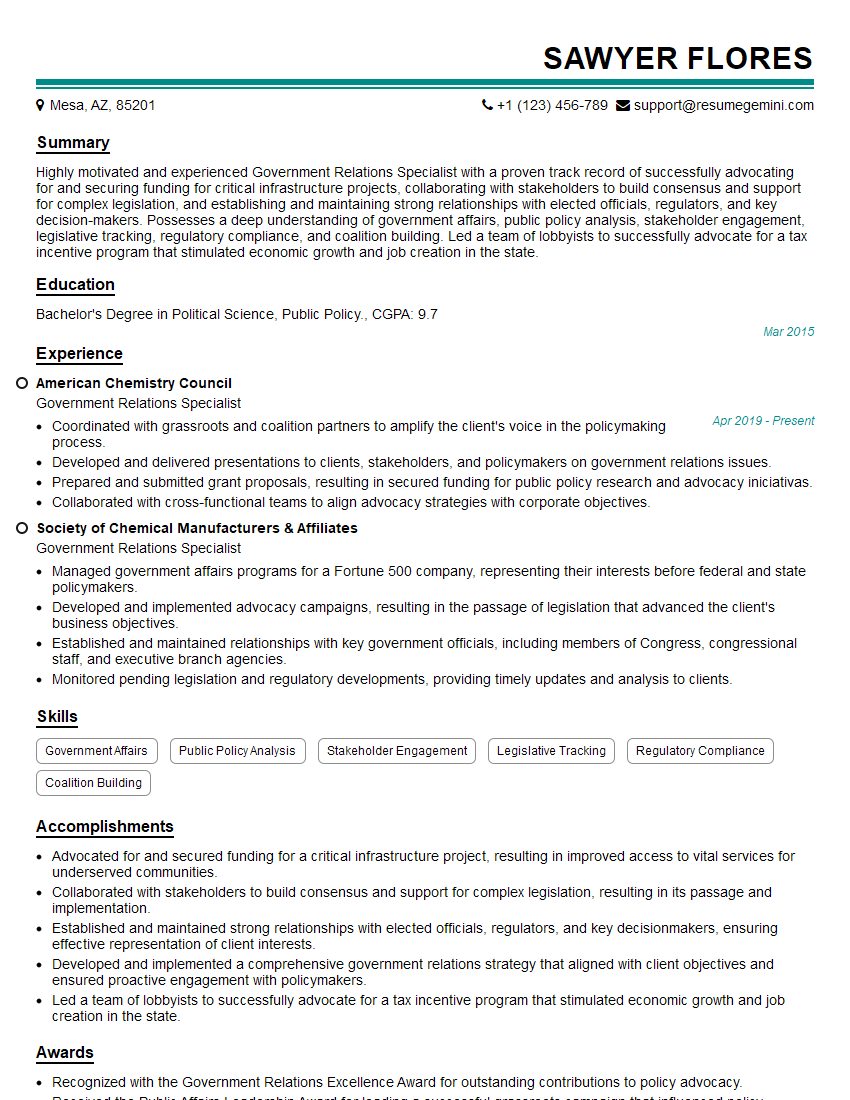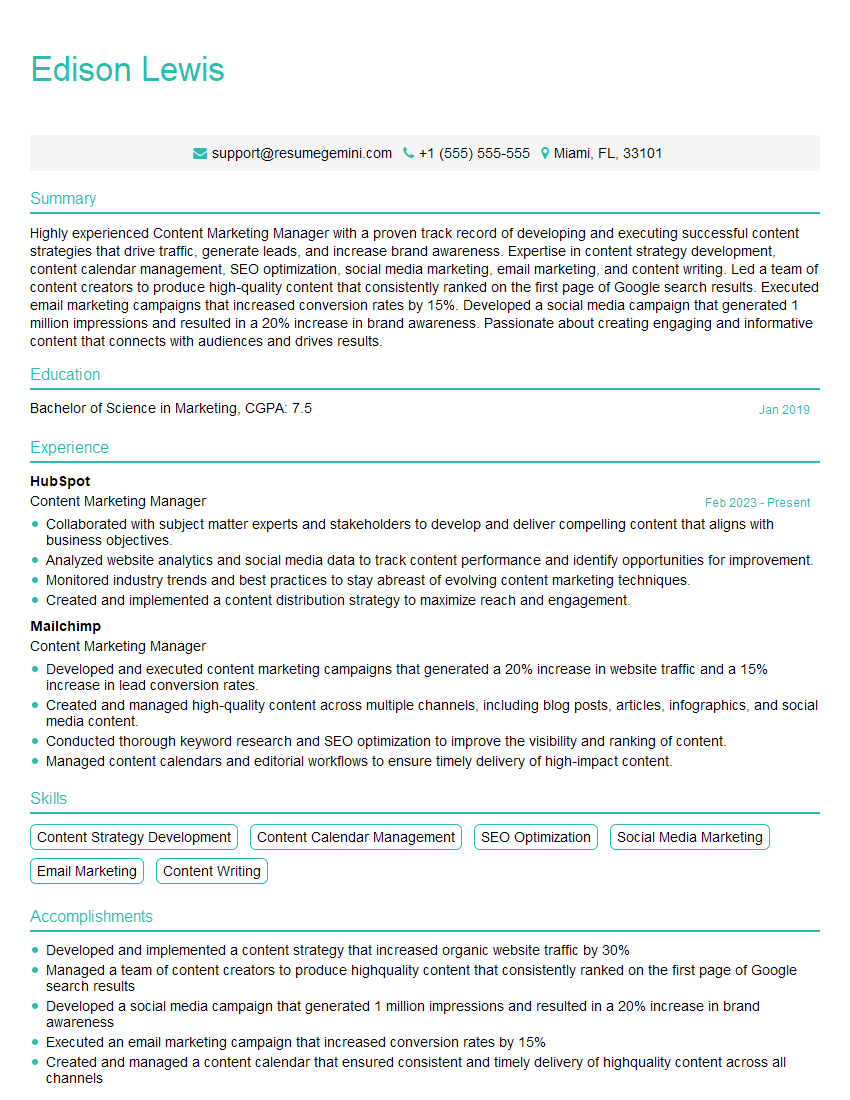Cracking a skill-specific interview, like one for Influence Operations, requires understanding the nuances of the role. In this blog, we present the questions you’re most likely to encounter, along with insights into how to answer them effectively. Let’s ensure you’re ready to make a strong impression.
Questions Asked in Influence Operations Interview
Q 1. Describe your experience designing and implementing influence campaigns.
Designing and implementing influence campaigns involves a multi-faceted approach that combines strategic planning, creative content development, and meticulous execution. My experience encompasses crafting campaigns across diverse platforms, targeting various demographics and achieving measurable results. For instance, in a recent project for a sustainable fashion brand, I developed a campaign focusing on micro-influencers on Instagram and TikTok. We leveraged authentic storytelling and user-generated content to highlight the brand’s commitment to ethical production. The campaign resulted in a significant boost in brand awareness and a notable increase in online sales. In another project for a non-profit organization, we utilized a multi-channel approach involving influencer collaborations, earned media outreach, and community engagement initiatives to promote a crucial fundraising drive. This integrated strategy led to exceeding the fundraising target by 25%.
The process typically starts with a deep understanding of the target audience, the desired message, and the available resources. This is followed by influencer identification and selection, content strategy development, campaign rollout, performance monitoring, and post-campaign analysis. Every step requires close attention to detail and adaptable strategies based on real-time data.
Q 2. Explain your understanding of the different phases of an influence operation.
An influence operation typically unfolds in several key phases. First is the Planning and Research Phase where the objectives, target audience, key messages, and appropriate channels are identified. This involves extensive market research and competitor analysis to ensure the campaign is strategically sound. Next comes the Influencer Identification and Selection Phase. Here, we identify and vet potential influencers aligning with the campaign’s goals and brand values. This involves assessing their audience demographics, engagement rates, and overall credibility. The Content Creation and Distribution Phase follows, involving the development of engaging and authentic content tailored to each influencer and platform. This phase requires close collaboration with influencers to ensure brand consistency and authenticity. The Campaign Monitoring and Evaluation Phase involves real-time tracking of campaign performance using relevant KPIs (discussed further in the next question). Finally, the Post-Campaign Analysis Phase involves assessing the overall success of the campaign, identifying areas for improvement, and drawing insights for future campaigns. This cyclical process allows for continuous refinement and improvement.
Q 3. How do you measure the success of an influence campaign?
Measuring the success of an influence campaign is crucial and goes beyond simple vanity metrics like likes and followers. We need to evaluate the campaign’s impact on key business objectives. This requires a multi-faceted approach. We use a combination of quantitative and qualitative metrics.
- Quantitative Metrics: Website traffic, sales conversions, lead generation, social media engagement (likes, shares, comments, brand mentions), reach, impressions.
- Qualitative Metrics: Brand sentiment analysis (tracking public perception), media coverage, influencer feedback, customer reviews, and surveys to gauge changes in brand awareness and perception.
By correlating these data points, we can accurately assess the campaign’s Return on Investment (ROI) and its overall effectiveness in achieving the stated objectives.
Q 4. What key performance indicators (KPIs) would you track in an influence operation?
The KPIs tracked in an influence operation vary based on campaign objectives. However, some core KPIs consistently provide valuable insights. These include:
- Reach and Impressions: How many unique users saw the campaign content?
- Engagement Rate: Likes, comments, shares, and other interactions. This reflects audience interest and resonance.
- Website Traffic and Conversions: Did the campaign drive traffic to the website, and did that traffic result in sales or lead generation?
- Brand Mentions and Sentiment: Tracking the volume and nature of brand mentions online (positive, negative, neutral). This helps assess the campaign’s impact on brand perception.
- Influencer Performance: Measuring each influencer’s contribution to overall campaign success, considering their audience engagement and impact on key metrics.
Regular monitoring of these KPIs allows for real-time adjustments and optimizations during the campaign.
Q 5. How do you identify key influencers for a specific target audience?
Identifying key influencers requires a strategic approach that goes beyond simply looking at follower count. We consider several factors:
- Audience Alignment: Do their followers align with our target demographic and interests?
- Engagement Rate: High engagement signifies genuine audience connection and influence.
- Content Relevance: Does their content align with our brand message and campaign themes?
- Authenticity and Credibility: Do they have a genuine following and a trustworthy reputation?
- Platform Relevance: Selecting influencers active on platforms frequented by the target audience.
Tools like influencer marketing platforms and social media analytics help us identify potential influencers and analyze their performance. We also conduct thorough background checks to ensure authenticity and alignment with our brand values.
Q 6. What strategies do you employ to build and maintain relationships with influencers?
Building and maintaining positive relationships with influencers is paramount for long-term success. We prioritize:
- Clear Communication: Open and transparent communication about campaign goals, expectations, and timelines.
- Mutual Respect and Value: Treating influencers as partners, acknowledging their expertise and contributions.
- Personalized Approach: Tailoring our communication and collaboration to each influencer’s individual style and preferences.
- Long-Term Partnerships: Cultivating ongoing relationships through consistent engagement and collaboration beyond individual campaigns.
- Fair Compensation and Recognition: Providing appropriate compensation and credit for their involvement.
By fostering these strong relationships, we create a network of trusted partners who are invested in our brand’s success.
Q 7. How do you handle negative feedback or criticism during an influence campaign?
Negative feedback or criticism is an inevitable part of any influence campaign. Our strategy involves a proactive and transparent approach:
- Monitoring and Tracking: Actively monitoring social media and online platforms for feedback, both positive and negative.
- Prompt Response: Addressing negative comments and criticisms promptly and professionally. This demonstrates responsiveness and a commitment to addressing concerns.
- Empathetic Engagement: Responding with empathy and understanding, acknowledging valid criticisms and offering solutions when possible.
- Transparency and Accountability: Acknowledging mistakes and taking responsibility for any shortcomings.
- Learning and Adaptation: Using negative feedback as an opportunity to learn and improve future campaigns.
Handling negative feedback effectively can transform potential crises into opportunities to enhance brand reputation and demonstrate authenticity.
Q 8. Describe your experience using social media analytics to track campaign performance.
Tracking campaign performance using social media analytics is crucial for understanding audience engagement and the effectiveness of our influence strategies. We leverage various tools to monitor key metrics. This involves more than just vanity metrics like likes and shares; it’s about understanding the *quality* of engagement.
- Sentiment Analysis: We use sentiment analysis tools to gauge public opinion towards our campaign messages. For example, we might track the sentiment around a specific hashtag related to our campaign, identifying whether the overall tone is positive, negative, or neutral. This allows us to adapt our messaging in real-time if necessary.
- Reach and Impressions: We meticulously track the reach and impressions of our posts and ads to understand how far our message is spreading. This helps us optimize our targeting and budget allocation.
- Audience Demographics: Analyzing audience demographics helps us understand who is engaging with our content and tailor our messaging to resonate better with specific segments. For example, we might find that a particular demographic is more responsive to visual content compared to text-based posts.
- Engagement Rate: Beyond likes and shares, we focus on deeper engagement metrics like comments, shares, and clicks. A high engagement rate indicates a successful campaign, while low engagement might suggest a need for messaging adjustments.
- Competitor Analysis: We monitor our competitors’ activities on social media, analyzing their strategies and performance to identify opportunities and potential threats.
For instance, during a recent campaign promoting sustainable tourism, we used social listening tools to identify emerging conversations around eco-friendly travel. We then adjusted our content strategy to align with these trends, leading to a significant increase in engagement and reach.
Q 9. How do you adapt your influence strategies to different cultural contexts?
Adapting influence strategies to different cultural contexts is paramount. A one-size-fits-all approach is rarely effective and can even be detrimental. Cultural nuances significantly impact how audiences receive and interpret messages.
- Language: Direct translation is insufficient; we need culturally appropriate language and phrasing. What’s considered polite or persuasive in one culture might be offensive or ineffective in another.
- Values and Beliefs: Understanding the core values and beliefs of the target audience is crucial. Messaging should resonate with their worldview and avoid contradicting established norms.
- Visuals and Symbols: Images, colors, and symbols carry different meanings across cultures. What’s positive in one culture might be negative in another. For example, certain colors associated with prosperity in one region could be associated with mourning in another.
- Media Channels: The preferred social media platforms and communication channels can vary considerably across cultures. Some cultures might favor video-based platforms while others prefer text-based communication.
- Local Collaborations: Working with local influencers and partners is extremely valuable. They possess deep cultural understanding and can help ensure that our messages are accurately and effectively conveyed.
For example, when launching a campaign in a collectivist culture, we focused on community benefits rather than individualistic gains, which resonated far better than a message emphasizing individual achievement.
Q 10. How do you manage risks and ethical considerations in influence operations?
Managing risks and ethical considerations is a critical aspect of influence operations. Transparency and accountability are vital. We adhere to a strict ethical framework, prioritizing authenticity and avoiding deceptive practices.
- Transparency: We clearly disclose our involvement in any influence campaigns, avoiding covert operations. We ensure that sponsored content is clearly labeled as such.
- Accuracy: We meticulously verify the accuracy of all information shared. Misinformation and disinformation can severely damage credibility and have harmful consequences.
- Respect for Privacy: We adhere to strict data privacy regulations and protect the privacy of individuals. We avoid collecting or using personal data without explicit consent.
- Avoiding Manipulation: We avoid using manipulative tactics or exploiting vulnerabilities in the target audience. Our aim is to inform and persuade, not deceive or coerce.
- Internal Audits: Regular internal audits ensure compliance with our ethical guidelines and legal regulations.
For example, if we identify potentially misleading information within a campaign, we immediately correct it and take steps to prevent similar situations in the future. We document all our actions and decisions to ensure transparency and accountability.
Q 11. Explain your understanding of legal and regulatory frameworks related to influence operations.
Understanding legal and regulatory frameworks related to influence operations is essential. These vary by jurisdiction and are constantly evolving. Key areas include:
- Advertising Disclosure Laws: We must comply with laws requiring disclosure of paid advertising and sponsored content. This includes clear labeling on social media posts and other online platforms.
- Data Privacy Regulations: We must adhere to data privacy laws like GDPR and CCPA, ensuring that we collect and use personal data responsibly and transparently.
- Campaign Finance Laws: In certain contexts, influence operations may be subject to campaign finance regulations, especially when related to political campaigns.
- Foreign Agent Registration Act (FARA): In the US, FARA requires individuals or organizations acting as agents of foreign principals to register with the Department of Justice. This applies to situations where influence campaigns are conducted on behalf of foreign entities.
- Anti-Bribery and Corruption Laws: We always ensure compliance with anti-bribery and corruption laws, avoiding any actions that could be construed as bribery or undue influence.
Staying informed about legal updates and consulting with legal experts are crucial to ensure compliance. We conduct thorough legal reviews before launching any influence operation.
Q 12. Describe your experience with crisis communication related to influence campaigns.
Crisis communication related to influence campaigns requires swift, decisive action. A well-defined crisis communication plan is vital for mitigating reputational damage and maintaining credibility.
- Rapid Response: We establish a rapid response team to address any negative events promptly. Speed is essential in minimizing the impact of a crisis.
- Transparency and Honesty: We communicate openly and honestly with stakeholders, acknowledging any mistakes and taking responsibility for our actions. Transparency builds trust and credibility.
- Consistent Messaging: We ensure consistent messaging across all communication channels to avoid confusion and maintain control of the narrative.
- Engagement with Stakeholders: We actively engage with concerned stakeholders, addressing their questions and concerns. This shows that we are actively listening and taking their feedback seriously.
- Post-Crisis Review: Following the crisis, we conduct a thorough review to identify areas for improvement and prevent similar incidents in the future.
In one instance, an unexpected negative event arose from a campaign. We immediately took ownership, issued a public apology, implemented corrective measures, and engaged constructively with critics. This proactive approach helped minimize the negative impact.
Q 13. How do you develop a compelling narrative for an influence operation?
Developing a compelling narrative for an influence operation involves crafting a persuasive story that resonates with the target audience. It’s about more than just delivering information; it’s about connecting emotionally.
- Understanding the Audience: We begin by thoroughly understanding the target audience’s values, beliefs, and aspirations. The narrative must be tailored to their specific needs and interests.
- Defining the Core Message: We distill the core message into a concise, memorable statement that captures the essence of the campaign.
- Creating an Emotional Connection: We use storytelling techniques to create an emotional connection with the audience. This might involve using compelling imagery, personal anecdotes, or relatable characters.
- Building Credibility: We build credibility by using trustworthy sources, providing evidence, and avoiding exaggeration or hyperbole.
- Consistent Messaging: We ensure consistent messaging across all communication channels to reinforce the core narrative.
For example, a campaign promoting a new health initiative used the story of a person who successfully improved their health through the program. This personal story resonated deeply with the audience, creating a powerful and emotional connection.
Q 14. What methods do you use to identify and mitigate misinformation in your campaigns?
Identifying and mitigating misinformation requires a multi-faceted approach. It involves proactive measures to prevent the spread of misinformation and reactive measures to counter its effects once it emerges.
- Fact-Checking and Verification: We use fact-checking tools and techniques to verify the accuracy of information before it’s shared. This includes cross-referencing information with reliable sources and consulting with subject matter experts.
- Source Monitoring: We closely monitor sources of information, identifying potentially unreliable or biased sources that might spread misinformation.
- Early Detection Systems: We employ social media monitoring tools and techniques to detect and track the spread of misinformation in real-time.
- Strategic Communication: We develop strategic communication plans to counter misinformation effectively. This involves providing accurate information, correcting false claims, and addressing concerns proactively.
- Community Engagement: We engage with communities to foster media literacy and empower individuals to identify and avoid misinformation.
In a recent campaign, we proactively addressed potential misinformation by preemptively publishing fact-checks and engaging with individuals who were spreading false narratives. This allowed us to correct misinformation quickly and effectively, minimizing its impact.
Q 15. How do you use data to inform your influence strategy?
Data is the bedrock of any effective influence strategy. We leverage data analytics to understand our target audience, identify key influencers, and measure campaign performance. This involves several steps:
- Audience Segmentation: We use demographic, psychographic, and behavioral data to segment our target audience into distinct groups with shared characteristics. This allows us to tailor messaging and channels for maximum impact. For example, we might segment based on age, location, political affiliation, or online activity.
- Influencer Identification: We employ social listening tools and data analysis to identify key influencers within each segment. This isn’t just about follower count; it’s about engagement, reach, and the credibility of the influencer within their community. We look at metrics like engagement rate, audience demographics, and the sentiment expressed towards the influencer.
- Message Testing and Optimization: A/B testing allows us to compare different messaging approaches and identify what resonates best with our target audience. Data on click-through rates, shares, and comments provides valuable feedback for refining our message.
- Campaign Performance Measurement: We track key metrics like reach, engagement, sentiment, and website traffic to assess campaign effectiveness. This data informs adjustments to our strategy throughout the campaign.
For instance, in a recent campaign promoting sustainable practices, we used data to identify environmentally conscious influencers on Instagram and TikTok. We A/B tested different video formats and messaging styles, ultimately finding that short, visually appealing videos with a clear call to action generated the highest engagement.
Career Expert Tips:
- Ace those interviews! Prepare effectively by reviewing the Top 50 Most Common Interview Questions on ResumeGemini.
- Navigate your job search with confidence! Explore a wide range of Career Tips on ResumeGemini. Learn about common challenges and recommendations to overcome them.
- Craft the perfect resume! Master the Art of Resume Writing with ResumeGemini’s guide. Showcase your unique qualifications and achievements effectively.
- Don’t miss out on holiday savings! Build your dream resume with ResumeGemini’s ATS optimized templates.
Q 16. Describe your experience developing and implementing content strategies for influence operations.
Developing and implementing content strategies for influence operations requires a deep understanding of the target audience and the desired outcomes. My approach is multi-faceted:
- Audience Research: We begin with thorough research to understand the audience’s values, beliefs, and information consumption habits. This informs the type of content we create, the platforms we use, and the tone and style of our messaging.
- Content Creation: We create diverse content formats, including articles, videos, infographics, social media posts, and even memes, depending on the audience and platform. The goal is to provide value and build trust. We might create informative content explaining a complex issue, share inspiring stories, or create interactive content to encourage participation.
- Channel Selection: We select the most appropriate channels for reaching our target audience. This might include social media platforms, news websites, blogs, or podcasts, depending on the audience’s preferences and the goals of the campaign. We don’t rely on a single channel, but rather a multi-channel approach for maximum reach.
- Content Distribution and Promotion: We use a range of techniques to distribute and promote our content, including paid advertising, influencer marketing, and organic social media engagement. We constantly monitor performance and adapt our strategy based on the results.
- Monitoring and Evaluation: We meticulously track key performance indicators (KPIs) such as reach, engagement, sentiment, and website traffic to assess campaign effectiveness and identify areas for improvement.
For example, in a public health campaign aimed at promoting vaccinations, we developed a series of short, easily digestible videos featuring relatable characters, shared them across multiple social media platforms, and partnered with health professionals to amplify the message. The result was significantly increased vaccine uptake.
Q 17. What are your preferred tools and technologies for managing influence campaigns?
Effective influence operations rely on a robust technology stack. My preferred tools include:
- Social Listening Tools: Brandwatch, Talkwalker, and Meltwater allow us to monitor conversations, identify influencers, and track sentiment around relevant topics.
- Social Media Management Platforms: Hootsuite and Buffer help us schedule posts, manage multiple accounts, and analyze campaign performance across different platforms.
- Data Analytics Platforms: Google Analytics, Tableau, and Power BI are crucial for analyzing website traffic, engagement metrics, and audience demographics.
- Collaboration and Project Management Tools: Asana, Trello, and Slack enable effective team communication and project coordination.
- Content Creation Tools: Canva, Adobe Creative Suite, and video editing software are essential for producing high-quality visual content.
The choice of specific tools depends on the needs of each campaign and the available budget. However, integrating these tools ensures a streamlined workflow and efficient data analysis.
Q 18. How do you build consensus among stakeholders in an influence operation?
Building consensus among stakeholders is critical for the success of any influence operation. This involves:
- Clear Communication: Establishing clear communication channels and regularly updating stakeholders on progress, challenges, and any changes in strategy is essential.
- Shared Goals and Objectives: Ensuring everyone is aligned on the campaign’s goals, target audience, and key performance indicators (KPIs) is paramount.
- Collaborative Planning: Involving stakeholders in the planning process from the outset allows for input and buy-in from all parties. This ensures that everyone feels heard and invested in the success of the campaign.
- Regular Feedback and Iteration: Regularly soliciting feedback from stakeholders and iterating the strategy based on that feedback fosters a sense of shared ownership and helps to address any concerns proactively.
- Transparency and Accountability: Maintaining transparency about the campaign’s progress, budget, and results builds trust and ensures accountability. Regular reporting keeps everyone informed and promotes collaboration.
For example, in a recent campaign, we held regular meetings with all stakeholders to present progress reports, discuss challenges, and brainstorm solutions. This ensured that everyone was kept informed and allowed us to proactively address any concerns.
Q 19. Describe your experience with budget management for influence campaigns.
Budget management for influence campaigns requires careful planning and meticulous tracking. This involves:
- Detailed Budgeting: Creating a detailed budget that outlines all expected costs, including content creation, media buying, influencer fees, technology, and personnel costs.
- Cost Allocation: Allocating budget across different channels and activities based on their expected ROI. For instance, we might allocate a larger portion of the budget to paid social media advertising if we’re targeting a large audience.
- Real-time Tracking and Monitoring: Tracking campaign spending in real-time allows for early identification of budget overruns or underperformance, enabling timely adjustments.
- Performance Analysis: Regularly analyzing campaign performance and comparing actual costs to the initial budget allows for identifying areas of efficiency and optimizing future campaigns.
- Reporting and Accountability: Providing regular budget reports to stakeholders ensures transparency and facilitates informed decision-making. This reporting must be clear, concise, and easy to understand.
We utilize spreadsheet software and project management tools to track expenses and ensure we stay within budget. We also use data analytics to inform our budget allocation, ensuring we maximize our ROI.
Q 20. How do you ensure transparency and accountability in your influence operations?
Transparency and accountability are essential for ethical and effective influence operations. We achieve this through:
- Clear Disclosure: We always disclose any relationships with influencers or other partners involved in our campaigns. This includes financial arrangements and any other material connections.
- Data Privacy: We strictly adhere to all relevant data privacy regulations and protect the personal information of our target audience and any individuals involved in the campaign.
- Auditable Processes: We maintain detailed records of all aspects of our campaigns, including budget allocations, content creation, media buys, and performance data. This makes it possible to audit our activities and ensure compliance with all relevant laws and ethical guidelines.
- Independent Audits: We are open to independent audits of our campaigns to verify our claims and demonstrate our commitment to ethical practices.
- Ethical Guidelines: We adhere to a strict code of ethics that governs our activities and ensures that our campaigns are conducted responsibly and ethically. This includes avoiding deceptive or manipulative tactics.
Building trust is crucial. Our commitment to transparency ensures that stakeholders and the public can have confidence in the integrity of our operations.
Q 21. Explain your understanding of different influence methodologies.
Influence methodologies vary widely, depending on the goals and context of the operation. Some key approaches include:
- Social Media Marketing: This involves creating and sharing engaging content on various social media platforms to build brand awareness, drive engagement, and influence opinions. This might utilize paid advertising, organic posting, or influencer marketing.
- Public Relations: This focuses on building and maintaining a positive public image through media outreach, press releases, and relationship building with journalists and influencers. The goal is to shape the narrative surrounding a particular issue or organization.
- Search Engine Optimization (SEO): This involves optimizing website content and structure to improve its ranking in search engine results pages (SERPs). This increases the visibility of information and can influence public perception.
- Grassroots Mobilization: This approach involves organizing and mobilizing individuals or groups to advocate for a specific cause or issue. This often involves creating a sense of community and shared identity amongst participants.
- Nudging and Framing: This involves using subtle psychological techniques to influence behavior or attitudes. Nudging refers to using gentle prompts to encourage certain actions, while framing involves presenting information in a way that emphasizes particular aspects.
Understanding the nuances of each methodology is crucial for developing effective and ethical influence strategies. Often, a combination of these approaches is used to maximize impact.
Q 22. How do you measure the ROI of an influence campaign?
Measuring the ROI of an influence campaign isn’t as straightforward as calculating a simple return on investment. It requires a multifaceted approach that considers both quantitative and qualitative data. We can’t just look at sales figures; we need to understand the impact on brand awareness, sentiment, and ultimately, behavior change.
Quantitative Metrics: These are the easily measurable aspects. Examples include:
- Website traffic and engagement: Tracking clicks, time spent on site, and conversion rates from influencer-driven content.
- Sales conversions: Attributing sales directly to specific influencer campaigns using unique discount codes or tracking links.
- Social media engagement: Monitoring likes, shares, comments, and mentions related to the campaign.
- Brand mentions: Tracking the volume and sentiment of mentions across various social media platforms and news outlets.
Qualitative Metrics: These are harder to quantify but equally important. They assess the campaign’s impact on brand perception and public opinion. We use methods like:
- Sentiment analysis: Using tools to gauge the overall sentiment (positive, negative, or neutral) towards the brand in online conversations.
- Brand lift studies: Measuring changes in brand awareness, favorability, and purchase intent before and after the campaign.
- Focus groups and surveys: Gathering direct feedback from target audiences to understand their perceptions of the campaign and its impact.
Attribution Modeling: A crucial aspect is correctly attributing the impact to the influencer campaign. This often involves sophisticated analytics and a clear understanding of the campaign’s timeline and other marketing activities.
Ultimately, ROI is calculated by comparing the total cost of the campaign (influencer fees, content creation, etc.) to the value of the achieved results (increased sales, brand awareness, etc.). This requires a carefully designed measurement plan implemented from the campaign’s outset.
Q 23. What are the ethical implications of using algorithms to influence public opinion?
The ethical implications of using algorithms to influence public opinion are profound and multifaceted. Algorithms, while powerful tools for targeting and personalization, can be easily misused to manipulate individuals and sow discord. Key concerns include:
- Bias and Discrimination: Algorithms trained on biased data can perpetuate and amplify existing societal biases, leading to unfair or discriminatory outcomes. For example, an algorithm targeting political ads might inadvertently favor one demographic group over another based on the data it was trained on.
- Lack of Transparency and Accountability: The complexity of many algorithms makes it difficult to understand how they arrive at their recommendations or targeting choices. This lack of transparency makes it challenging to hold those responsible accountable for the consequences of algorithmic manipulation.
- Echo Chambers and Polarization: Algorithms can create echo chambers by showing users only information that reinforces their existing beliefs, leading to increased polarization and reduced exposure to diverse perspectives.
- Manipulation and Misinformation: Algorithms can be used to spread misinformation and propaganda more effectively and efficiently than traditional methods. This can undermine trust in institutions and democratic processes.
Addressing these ethical concerns requires a multi-pronged approach: developing ethical guidelines for the development and deployment of these algorithms, promoting transparency in their use, and fostering critical thinking skills among the public to identify and resist manipulation.
Q 24. How would you address a situation where an influencer violates campaign guidelines?
Addressing an influencer who violates campaign guidelines requires a swift, consistent, and transparent process. The response depends on the severity of the violation.
Step 1: Investigation and Documentation: First, thoroughly investigate the reported violation, gathering all relevant evidence (screenshots, social media posts, etc.). Document the violation clearly and objectively.
Step 2: Communication and Feedback: Contact the influencer privately and explain the violation, citing specific guidelines they breached. Provide specific examples and explain the consequences of their actions. The tone should be professional but firm.
Step 3: Remedial Actions: Based on the severity, the response might range from a simple warning and request for content removal to contract termination and potential legal action. For less severe violations, a retraining or clarification on guidelines might be sufficient.
Step 4: Content Removal and Damage Control: If necessary, work with the influencer to remove the violating content. If significant damage has been caused to the brand’s reputation, a proactive damage control strategy might be needed, possibly including public statements.
Step 5: Review and Prevention: Following the incident, review campaign guidelines and internal processes to prevent similar situations in the future. This might involve stricter guidelines, enhanced monitoring procedures, or improved communication with influencers.
The goal is to maintain a positive working relationship while ensuring adherence to the agreed-upon campaign standards. Consistent enforcement is key to preventing future violations.
Q 25. How do you stay up-to-date with the latest trends and technologies in influence operations?
Staying updated in the dynamic field of influence operations requires a multifaceted strategy. I leverage a variety of resources to maintain my expertise:
- Industry Publications and Blogs: I regularly read leading industry publications and blogs focusing on digital marketing, social media trends, influencer marketing, and public relations. This allows me to stay informed about emerging trends and best practices.
- Conferences and Webinars: Attending industry conferences and webinars provides access to the latest research, insights, and networking opportunities. These events often feature leading experts who share their knowledge and experience.
- Professional Networks: Engaging with professional networks on platforms like LinkedIn helps me stay connected with other professionals in the field, exchanging ideas and learning from their experiences.
- Social Media Monitoring: I actively monitor social media platforms to identify emerging trends and analyze how influencers are using different platforms to reach their audience. This provides valuable insights into what’s working and what’s not.
- Technology Monitoring: I stay informed about new technologies and platforms relevant to influence operations, including social listening tools, influencer marketing platforms, and analytics dashboards. This allows me to leverage the most effective tools for campaign execution and measurement.
This continuous learning ensures my strategies remain relevant, effective, and ethically sound in the ever-evolving landscape of influence operations.
Q 26. Describe a time you had to adapt your strategy mid-campaign due to unforeseen circumstances.
During a campaign promoting a new sustainable fashion line, we faced an unforeseen crisis. A competing brand launched a negative PR campaign attacking the sustainability claims of our client. This created a significant challenge mid-campaign, threatening to undermine our efforts and damage our client’s reputation.
Our initial strategy focused on positive messaging and showcasing the product’s eco-friendly features. We quickly adapted our approach. First, we conducted a thorough analysis of the competing brand’s claims, identifying inaccuracies and inconsistencies. We then developed a swift response strategy involving:
- Fact-checking and transparency: We published a detailed blog post addressing the competitor’s claims, providing evidence to support our client’s sustainability certifications and practices.
- Influencer engagement: We engaged our influencers to share the blog post and respond to any negative comments on their platforms, emphasizing factual information and transparency.
- Proactive PR: We reached out to relevant media outlets to share our response, providing additional context and highlighting the credibility of our client’s sustainability efforts.
This proactive, multi-pronged strategy helped us neutralize the negative campaign, maintain our client’s reputation, and ultimately achieve most of our campaign goals. It showcased the importance of adaptability and crisis management in influence operations.
Q 27. How do you utilize A/B testing in influence campaigns?
A/B testing is a crucial component of optimizing influence campaigns. It allows us to test different elements of the campaign to determine which approaches are most effective in achieving the desired outcomes.
In influence campaigns, we can A/B test various aspects:
- Influencer Selection: Testing different influencers with similar audiences to see who generates higher engagement and conversions.
- Content Formats: Comparing the performance of different content formats, such as videos, images, and written posts, to identify the most resonant style with the target audience.
- Call to Actions (CTAs): Experimenting with different CTAs (e.g., “Shop Now,” “Learn More,” “Sign Up”) to determine which drives the most clicks and conversions.
- Creative Assets: Comparing different visuals or copy variations within the same influencer’s content to see which performs better.
- Platform Targeting: Testing different platforms (Instagram, TikTok, YouTube, etc.) to identify the most effective channels for reaching the target audience.
For instance, we might test two different Instagram posts from the same influencer promoting the same product: one with a video showcasing product features, and the other with a carousel of static images. By tracking engagement metrics (likes, comments, shares, website clicks), we can determine which creative approach resonates better with the target audience and optimize future campaigns accordingly.
A/B testing is an iterative process. We continuously analyze results, learn from them, and make data-driven decisions to improve campaign performance.
Q 28. What experience do you have with influencer marketing platforms?
My experience with influencer marketing platforms is extensive. I’ve worked with a variety of platforms, each offering different functionalities and strengths. I’m proficient in using tools for:
- Influencer Discovery and Management: Platforms like Upfluence, Grin, and AspireIQ allow for efficient identification, vetting, and management of influencers based on specific criteria (e.g., audience demographics, engagement rates, niche relevance).
- Campaign Creation and Tracking: These platforms offer features for campaign creation, scheduling, content distribution, and performance tracking. They provide detailed analytics on engagement, reach, and conversions, allowing for data-driven optimization.
- Communication and Collaboration: Many platforms facilitate seamless communication between brands and influencers, making it easier to manage campaign briefs, provide feedback, and track progress.
- Payment and Reporting: These platforms often integrate payment processing systems and offer comprehensive reporting features to streamline campaign management and track ROI.
My experience extends beyond simply using the platforms; I understand how to leverage their features strategically to achieve specific campaign objectives. For example, I use advanced analytics to identify high-performing influencers, track campaign effectiveness across multiple platforms, and provide insightful reports demonstrating the value of the influence campaigns. I also understand the limitations of each platform and can adapt my strategies accordingly to maximize efficiency and effectiveness.
Key Topics to Learn for Influence Operations Interview
- Strategic Communication: Understanding the nuances of crafting persuasive messages tailored to diverse audiences, considering cultural contexts and communication styles.
- Data Analysis & Insights: Analyzing data to identify key influencers, understand audience sentiment, and measure the effectiveness of influence campaigns. This includes interpreting social media analytics and other relevant data sources.
- Stakeholder Management: Building and maintaining strong relationships with key stakeholders, including internal teams, external partners, and influencers. This requires skillful negotiation and conflict resolution.
- Campaign Development & Execution: Designing and implementing comprehensive influence campaigns, setting clear objectives, defining key performance indicators (KPIs), and managing resources effectively.
- Ethical Considerations: Understanding and adhering to ethical guidelines and best practices in influence operations, ensuring transparency and accountability in all actions.
- Crisis Communication & Management: Developing strategies to manage and mitigate reputational risks and navigate challenging situations requiring swift and effective communication.
- Technology & Tools: Familiarity with relevant software and tools used in influence operations, such as social media management platforms, analytics dashboards, and communication technologies.
- Measurement & Evaluation: Utilizing appropriate metrics to assess the success of influence campaigns, demonstrating a clear understanding of ROI and impact.
Next Steps
Mastering Influence Operations opens doors to exciting and impactful career opportunities, offering the chance to shape narratives, drive change, and contribute significantly to organizational success. To maximize your job prospects, creating a compelling and ATS-friendly resume is crucial. ResumeGemini offers a trusted platform to build a professional resume that highlights your skills and experience effectively. We provide examples of resumes tailored to Influence Operations to help you showcase your capabilities and land your dream role.
Explore more articles
Users Rating of Our Blogs
Share Your Experience
We value your feedback! Please rate our content and share your thoughts (optional).
What Readers Say About Our Blog
Hello,
We found issues with your domain’s email setup that may be sending your messages to spam or blocking them completely. InboxShield Mini shows you how to fix it in minutes — no tech skills required.
Scan your domain now for details: https://inboxshield-mini.com/
— Adam @ InboxShield Mini
Reply STOP to unsubscribe
Hi, are you owner of interviewgemini.com? What if I told you I could help you find extra time in your schedule, reconnect with leads you didn’t even realize you missed, and bring in more “I want to work with you” conversations, without increasing your ad spend or hiring a full-time employee?
All with a flexible, budget-friendly service that could easily pay for itself. Sounds good?
Would it be nice to jump on a quick 10-minute call so I can show you exactly how we make this work?
Best,
Hapei
Marketing Director
Hey, I know you’re the owner of interviewgemini.com. I’ll be quick.
Fundraising for your business is tough and time-consuming. We make it easier by guaranteeing two private investor meetings each month, for six months. No demos, no pitch events – just direct introductions to active investors matched to your startup.
If youR17;re raising, this could help you build real momentum. Want me to send more info?
Hi, I represent an SEO company that specialises in getting you AI citations and higher rankings on Google. I’d like to offer you a 100% free SEO audit for your website. Would you be interested?
Hi, I represent an SEO company that specialises in getting you AI citations and higher rankings on Google. I’d like to offer you a 100% free SEO audit for your website. Would you be interested?
good
